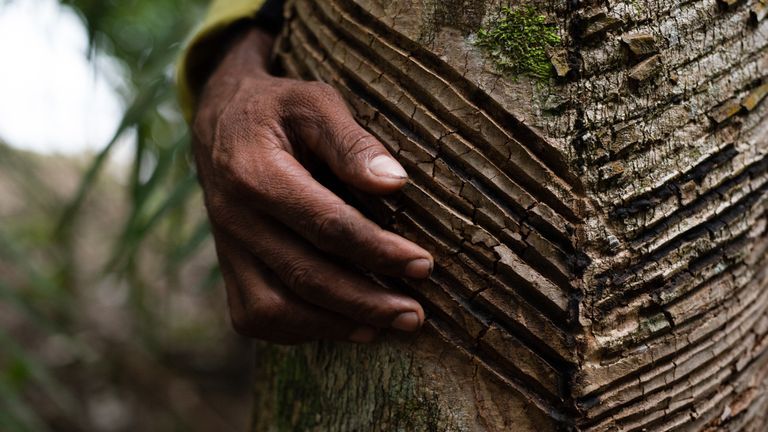"This one here is a dragon tree (Croton lechleri). Its sap is known as dragon's blood and serves as a remedy for stomach pains, ulcers, infections, and even cancer," explains Francisco Chico Brito, known by the community as Chico Preto. He's a rubber tapper and one of the 400 remaining residents of the Guariba-Roosevelt Extractive Reserve (Resex), at the extreme north of Mato Grosso. He points to his favorite tree with the enthusiasm of a young boy - despite his 52 years - while walking in a stand of dense rainforest. According to phytophysiognomy, some of the largest trees in the Amazon can be found in this area.
The dark trunk bleeds red resin while Chico nimbly carves a "V," the mark of the rubber tappers, to drain the liquid. He extracts the sap from the dragon tree without having to knock it down. He laments that few people recognize the wealth that seeps between his fingers. "I'm sad that there are few buyers now," he tells me. "A young man from Manaus arrived here and took liters of blood last year, but this year I almost didn't sell any -- only to the people here in the Resex who use the blood as medicine."
To read the full version of this article in Portuguese, visit National Geographic Brasil's website.
Esta aqui é dragoeira [Croton lechleri]. Sua seiva é conhecida como o sangue do dragão e serve de remédio para dores de estômago, úlcera, infecção e até para o câncer”, explica Francisco Chico Brito, conhecido como Chico Preto, seringueiro e um dos 400 moradores da Reserva Extrativista (Resex) Guariba-Roosevelt, no extremo norte de Mato Grosso. Ele aponta para sua árvore preferida com entusiasmo de um menino – apesar de seus 52 anos – enquanto caminha numa porção de floresta ombrófila densa – fitofisionomia onde estão os bosques das grandes árvores amazônicas.
O tronco escuro sangra a resina vermelha enquanto Chico agilmente talha na casca um V, a marca dos seringueiros, para escoar o líquido. Ele extrai a seiva da dragoeira sem precisar derrubar a árvore, mas lamenta poucos reconhecerem a riqueza que brota entre os seus dedos. “Fico triste, são poucos os compradores agora”, me conta. “Um moço de Manaus chegou aqui e levou litros do sangue ano passado, mas este ano eu quase não vendi, apenas para o pessoal da Resex, que usa o sangue como remédio.
